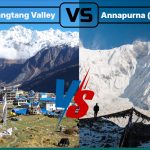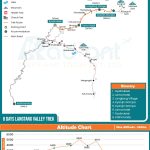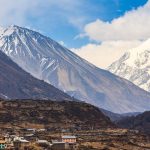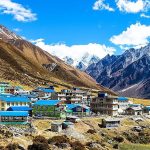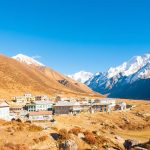Discover the Langtang Valley Trek in April, one of Nepal’s most accessible Himalayan adventures that is just 120 km from Kathmandu. Starting from Syabrubesi, this moderately difficult trek passes through rhododendron forests, charming Tamang villages and scenic Langtang Park, home to red pandas and Himalayan black bears.
April brings clear skies, mild temperatures and vibrant wildflowers, and these things make this month an ideal time for fit beginner hikers. This month is known for daylight of about 12 hours, minimal rainfall and snow-free trails that lead to viewpoints like Kyanjin Ri and Tserko Ri. In such conditions, hikers enjoy both comfort and panoramic mountain views.

Add to that the warmth of Tamang hospitality, Buddhist monastries and fewer crowds before the arrival of the monsoon. Therefore, the Langtang Valley trek in April becomes a perfect mix of natural beauty and cultural immersion.
Highlights
- Being in Langtang Valley in April means trekking in mild temperatures, minimal rainfall and drier trails
- Chance to witness a rhododendron bloom across Langtang Valley in April
- Clear skies allow best and sharpest views of Langtang Lirung, Dorje Lakpa, Tserko Ri and Kyanjin Ri
- Accommodation is fully operation by April and offer warm meals and communal dining
- Safe trekking possible as there is low risk of avalanches and landslides
Why Trek Lantang Valley in April?
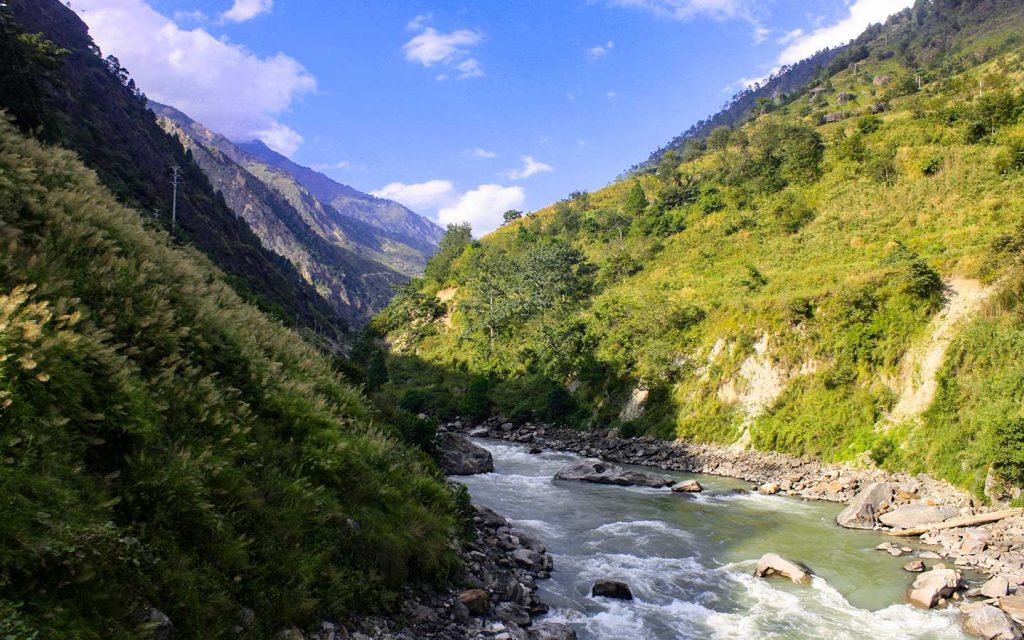
If you are excited to hike to Langtang Valley, April is one of the best months. One of the reasons behind this is that the month brings together the best of Nepal’s spring. That means you can witness pleasant weather, clear skies and colorful rhododendron forests.
Therefore, April is known for creating a balance between comfort, scenery and accessibility when exploring the Langtang Valley.
Here is a detailed description of why the April Langtang Valley trek is recommended.
Ideal Spring Weather for Trekking
The climate of Langtang Valley in April provides some of the most stable conditions for trekking in the region. They include the moderate daytime temperatures of April. As such, they create a comfortable atmosphere for walking.
Likewise, rainfall in April stays under 50mm, unlike during the monsoon, when it can be as high as 300mm. This means the trails in Langtang Valley are mostly dry and clear.
In addition to that, snow that accumulated on the trails over winter gradually melts by the middle of April. As a result, it is easier and safer to reach high-altitude sections like Kyajin Gompa and Tserko Ri.
With about 12 hours of daylight, trekkers can also enjoy long walking days without rushing between stops.
Rhododendron Blooms and Spring Colors
The Langtang National Park transforms into a colorful paradise in April. The region bursts into color as rhododendrons bloom in rich shades of red, pink and white as they carpet the hillsides and add a magical charm to every trail.
Meanwhile, the national park also hosts diverse flora and fauna. They include Himalayan monals, red pandas and langurs. Along with trekking, April provides the ideal setting for photographers and nature lovers to capture Langtang’s spring beauty.
Good Visibility and Mountain Views
April in Langtang is known for its clear skies, which offer excellent visibility. That means there is a high chance of getting those unobstructed views of the mountains. As such, trekkers can enjoy crisp panoramas of peaks like Langtang Lirung and Dorje Lakpa, among others.
Remember that the early mornings, in particular, bring clear and sharp vistas before the valley winds rise. They may occasionally create light afternoon haze.
Similarly, the clarity of April also enhances the scenic trek to Kyanjin Ri or Tserko Ri. You should not miss these destinations, as it is where the entire Langtang range unfolds in spectacular fashion.
Safe and Comfortable Trail Conditions
Most of the winter snow has melted by April. This means it reduces the risk of slippery sections and blocked routes. The trail remains firm and dry in this month. Likewise, the risk of landslides, which are common in late summer after heavy rains, remains very low.
In addition, all teahouses and lodges are fully open by this spring month. This means that there is a consistent availability of accommodation and food options throughout the Langtang Valley.
But do note that because April is the peak trekking season in Nepal, some lodges may raise their prices, and popular areas like Kyanjin Gompa may get busy. Yet, the crowds are far smaller than in the Everest or Annapurna regions during the same period.
April Weather in Langtang Valley

April provides the ideal combination of warmth, clarity and minimal precipitation in Langtang Valley, resulting in nearly ideal trekking weather.
In April, lowland areas like Syaburbesi (1,503m) enjoy daytime temperatures of 10°C to 23°C. And it is ideal for hiking through lush forests. Meanwhile, the temperatures in higher elevations like Kyanjin Gompa (3,865m) range from -3°C to 10°C during the day in April.
The mornings this month are crisp, and they warm up into sunny afternoons. And with over 12 hours of daylight, trekkers get ample time to trek and also soak in views of peaks like Langtang Lirung.
Meanwhile, nighttime temperatures can drop to -5°C at higher elevations. But that does not mean one needs to face the harsh cold of winter in April.
Therefore, April is comfortable for long days on the trail. In addition, rainfall is scarce and the average precipitation is under 50mm, compared to the monsoon’s 300mm.
However, brief afternoon showers may pop up as pre-monsoon patterns begin. These are typically short and manageable, leaving trails dry and free of snow. Ultimately, this reduces risks of slips and avalanches.
But as you climb higher, the air gets thinner and it further intensifies sun exposure, especially above 3,000 meters. Therefore, it is mandatory that you apply sunscreen regularly and use sunglasses.
Likewise, occasional afternoon haze from valley winds may slightly blur distant views. But clear skies ensure stunning visibility most days.
April’s stable and mild conditions mean the days are warmer than the chill of the autumn. Also the trails are drier than monsoon mud.
Therefore, April is a prime month for trekking, as it offers both comfort and vibrant landscapes for unforgettable Himalayan adventures.
Langtang Valley Trek: April Route Overview

The Langtang Valley trek, which can last 8 or 10 days, is a journey reaching 5,033 meters at Tserko Ri. And the spring’s vibrant colors and favorable conditions make the trail alive.
This moderate trek begins from Syabrubesi and continues through Nepal’s Langtang National Park and Tamang Villages. Similarly, clear skies in April, mild temperatures, and blooming landscapes enhance every aspect of the trek.
Here is a breakdown of the itinerary to reflect how April enhances the Langtang Valley trek route’s diverse terrain and culture as well as vistas.
Travel to and from Trailhead
The trek begins and ends with a 120km drive — about 6 to 7 hours each way — between Kathmandu and Syabrubesi at an elevation of 1,503 meters along the scenic Trishuli River. In April, clear skies with good visibility reveal rolling green hills and distant snow-capped peaks. This makes the journey visually spectacular.
The trek permits are checked at Dhunche, a small town en route. Here, trekkers can stretch their legs.
Meanwhile, Syabrubesi, the trailhead, basks in mild 20°C temperatures and this is perfect for acclimatization before hiking.
The drive from Kathmandu to Syabrubesi via buses or private jeeps is reliable. It is also comfortable, as the roads are in good condition in spring.
This segment sets the tone for the trek ahead. And sunny weather in this month offers a warm welcome to the Himalayan adventure.
Lowland Forests and Rivers
During the trek from Syabrubesi to Lama Hotel, you can trace forests and rivers. Starting from Syabrubesi, this stretch follows gentle, forested trails alongside the Langtang Khola river.
April’s lowland temperatures of 10°C to 23°C bring out vibrant rhododendron blooms in red and white. And this creates a colorful canopy along the trekking trail and feels as if you are walking through a living painting. Langur monkeys are active in warmer spring weather and you may see them swinging through the trees.
Suspension bridges over the clear and rushing Langtang Khola offer stunning photo opportunities. And the spring’s vibrant colors and favorable conditions make the trail alive. It is a unique experience.
The trails are free from snow, typically in the middle of April. It means the footing is stable for the moderate 5 to 6 hours of trekking every day. Cozy teahouses in Lama Hotel provide warm meals like dal bhat and basic lodging. This is, without doubt, a delightful introduction to Langtang’s natural beauty.
Mid-Altitude Villages and Pastures
This section starts from Lama Hotel and climbs through Langtang Village before reaching Kyanjin Gompa. And this part of the trekking trail is a perfect blend of cultural and scenic highlights. April’s mild weather, with temperatures between 5°C and 10°C, enlivens Tamang villages.
Likewise, Langtang Village features houses made of sturdy stones. The trail weaves through lush yak pastures and past waterfalls. The flow of these waterfalls seems to be amplified by spring snowmelt.
At Kyanjin Gompa, you get to see clear views of glaciers and the surrounding peaks. And that is possible due to the clear skies of spring.
Steady climbs during the trek are manageable due to trek-friendly April weather. April’s stable conditions are what most trekkers desire, as this month offers safe trails and vibrant greenery. All these factors make this segment a heartwarming blend of nature and culture.
High-Altitude Viewpoints
The high-altitude highlights of the Lantang Valley trek in April include side hikes to Tserko Ri at an elevation of 5,033 meters and Kyanjin Ri at an elevation of 4,773 meters. April’s snow-free trails simplify these steep but non-technical ascents. And they are ideal for beginners with moderate fitness.
With clear skies, morning hikes deliver unobstructed 360° panoramas of Langtang Lirung, Ganesh Himal and surrounding peaks. You can see them often dusted with spring snow.
Tserko Ri, the trek’s highest point, rewards trekkers with sweeping views in April. Meanwhile, Kyanjin Ri offers a slightly easier climb with equally stunning vistas.
It is necessary to time hikes for early morning in April to avoid afternoon haze. Ultimately, this is the way to maximize visibility. These viewpoints, reachable without climbing gear, are April’s pinnacle. And they offer trekkers a sense of achievement amid breathtaking Himalayan scenery.
Descent through Spring Landscapes
The descent of this trek retraces the route from Kyanjin Gompa through Lama Hotel to Syabrubesi. April’s haze-free mornings highlight jagged peaks. And blooming rhododendrons and warm lowlands create a vibrant farewell to your nearly week-long trek.
If anyone is taking an optional detour to Sherpa Gaun, they may experience spring vistas of terraced fields and distant mountains. Trekking poles can ease long downhill stretches, and paths wind through forests teeming with birdlife. Teahouses serve hearty meals, fueling the descent.
Preparation for April Trek

To truly enjoy the April journey of Langtang Valley, proper preparation makes all the difference. With dry trails, rhododendrons in full bloom and mild weather, April is ideal for both first-timers and seasonal hikers. Yet one must get ready in different aspects before lacing up boots and heading north from Kathmandu for the April trek of Langtang Valley.
Physical and Mental Preparation
The Langtang Valley trek is considered moderately difficult, and the pleasant weather condition in April means it is not that challenging to undertake this journey. But one need not undermine the importance of proper preparation to be a part of this trek.
That is because trekkers need to walk between five and seven hours a day. And this includes gradual ascents through forests and villages before reaching higher elevations such as Kyanjin Gompa and Teserko Ri. Good fitness is one of the few factors that is essential to enjoy the trail instead of struggling through it.
So, whether you are opting for the April Langtang Valley trek or choose to be a part of this journey at other times of the year, start preparing about a month before the trek.
You can start by training yourself with a mix of cardio exercises, like hiking, jogging and cycling. Also, do not miss training on leg-strength workouts. You can practice squats and stair climbs. Also, walk with a light backpack to simulate trekking conditions, as this makes the journey easier.
Likewise, one needs to be mentally ready before starting the April Langtang Valley trek. Altitude and long walking days can test trekkers’ patience and stamina. Therefore, a positive mindset and flexibility, as well as respect for local culture, are essential if you want to make your trek enjoyable.
Permits and Logistics
Every trekker entering the region must carry the Langtang National Park Entry Permit. It can be arranged easily in Kathmandu or through your trekking agency. If you choose to travel with us, Radiant Treks can arrange the permit for you.
The trek usually begins at Syabrubesi, which is about a seven-hour drive away from Kathmandu. Carry enough cash in Nepali rupees, as there are no ATMs beyond Syabrubesi.
Packing Essentials for April
If you want to be a part of the Langtang Valley Trek in April, you should pack lightweight gear while addressing the changing weather conditions of spring. In this month, you face warm and sunny days as well as chilly nights. So, layering is key to staying comfortable.
Here’s a practical list of essentials needed for the trek without overloading your pack.
Clothing
- Bring 2–3 quick-dry trekking shirts to stay fresh on sweaty climbs, as they dry fast and handle April’s warmth well.
- Bring 2 pairs of convertible trekking pants with zip-off legs.
- Carry a fleece or lightweight down jacket, as it is necessary for cool evenings.
- A waterproof and windproof shell protects against occasional afternoon showers.
- Thermal underwear keeps you cozy at higher altitudes.
- Don’t forget a warm hat, buff, and gloves for chilly nights, plus a sun hat and UV-protection sunglasses to combat April’s intense UV index.
- Pack 3–4 pairs of trekking socks and 1 pair of thick socks for sleeping.
Footwear and Gear
- Bring sturdy and broken-in trekking boots with good grip. They are essential for a comfortable walk on varied terrain.
- Lightweight camp shoes or sandals offer relief when you are relaxing at teahouses after hours of trekking every day.
- A 40–50L backpack with a rain cover handles your load, and trekking poles ease steep descents, especially on the 32km return.
Sleeping and Accessories
- A four-season sleeping bag (rated to -10°C) ensures warmth at high altitudes.
- A towel that dries fast and a sleeping liner add comfort in basic teahouses.
- Pack a headlamp with spare batteries for early starts or late arrivals.
- Include a power bank or solar charger in your trekking packing list for spotty Wi-Fi access along the trail.
- Carry reusable water bottles with a capacity of 3–4L total as well as purification tablets or a filter.
Personal Items
- Carry sunscreen with an SPF of 30 or higher, lip balm, and basic toiletries.
- Bring a first-aid kit containing items for blister care as well as pain relievers and altitude medication.
- Wet wipes and sanitizer are essential in places with a shortage of water, so carry them.
- Add snacks or energy bars for a quick bite during the hikes.
Food and Accommodation
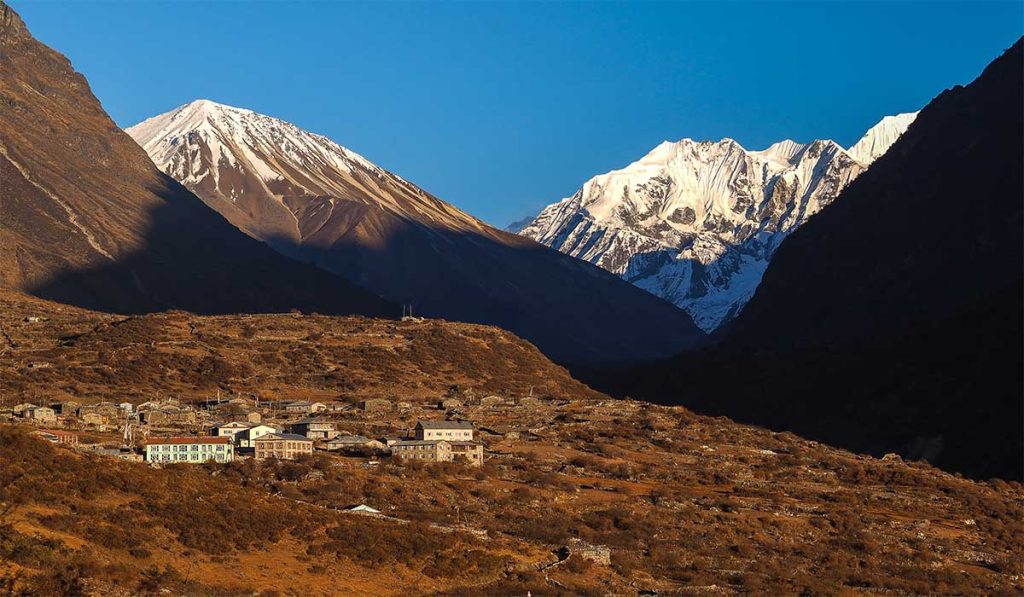
Teahouses along the Langtang Valley Trek provide simple yet comfortable lodging for trekkers. And in April, most of them are fully open after the winter lull.
Rooms are basic — usually twin beds with foam mattresses, blankets and a shared bathroom. At lower altitudes, some lodges offer private bathrooms and hot showers (for a small extra fee), while higher up, facilities become more rustic.
A four-season sleeping bag is still recommended, as nights can drop below freezing in places like Kyanjin Gompa. Similarly, a wood or yak-dung stove heats the cozy dining halls in many teahouses. Trekkers gather in such halls during the evenings and share their stories of Himalayan adventure.
Meals are hearty and designed to keep you fueled for long days of walking. The staple dish, dal bhat, is one of them. It is a platter of rice, lentil soup, vegetables and pickles and it provides the perfect mix of energy and comfort.
Other common options include noodle soups, fried rice, momos (dumplings) and Tibetan bread with honey or eggs for breakfast. Hot drinks like tea, coffee, and lemon ginger honey are available throughout the trail.
Food prices vary with altitude. And bottled water becomes costly at higher altitudes. So, it is wise to bring a water purifier or filter bottle to refill from taps or streams. This saves you cost.
April’s mild weather and open facilities make mealtimes sociable and relaxing. Sharing stories over dal bhat while the stove crackles nearby is part of the Langtang experience – simple comforts that turn each teahouse into a warm Himalayan home for the night.
April Challenges and Safety Tips
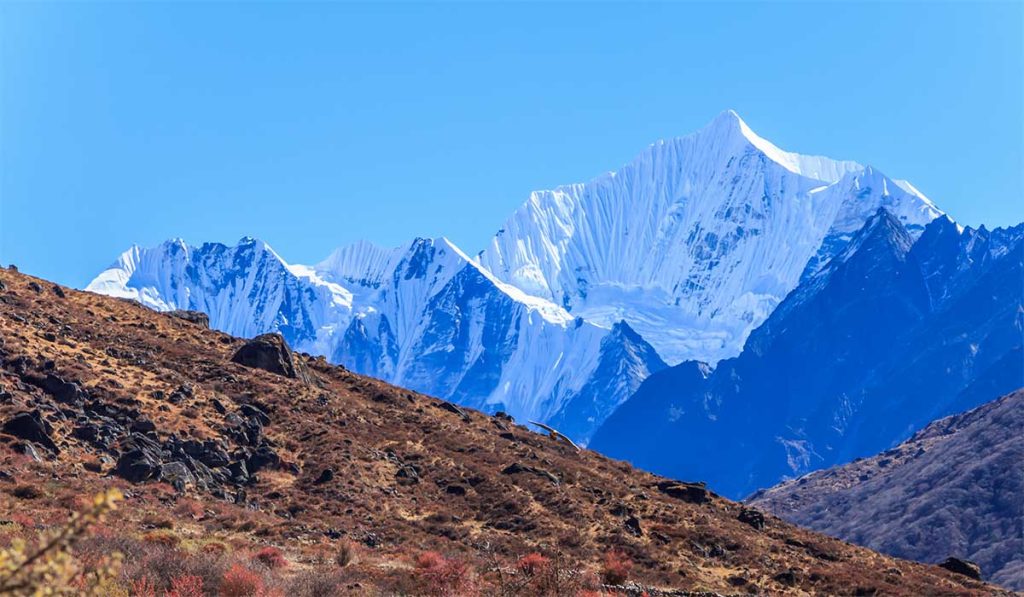
Safety on the Langtang Valley trek in April largely depends on pace, awareness and preparation. Trekkers still face challenges, such as altitude and long walking days, despite the weather being stable in April.
As such, the risk of Acute Mountain Sickness is always there. It can occur above 3,000 meters on any trekker. So, monitor your body for symptoms like headaches, dizziness and nausea. If you experience any of them and the condition worsens, then you need to descend.
Likewise, always carry trekking poles, as you may want to use them to maintain balance on steep or slippery descents. This comes in handy, especially after light rainfall.
In addition, avoid feeding or approaching yaks while on the trails. That is because these animals can be unpredictable on narrow trails.
April’s mild weather conditions mean there is a low risk of avalanche. However, afternoon haze may still obscure mountain views. To avoid traveling in bad weather, check local weather forecasts each morning.
Guides carry satellite phones for communication in remote areas where mobile networks fade. To stay safe and comfortable, trek slowly to acclimatize. Also, use sunscreen for strong UV exposure.
FAQS
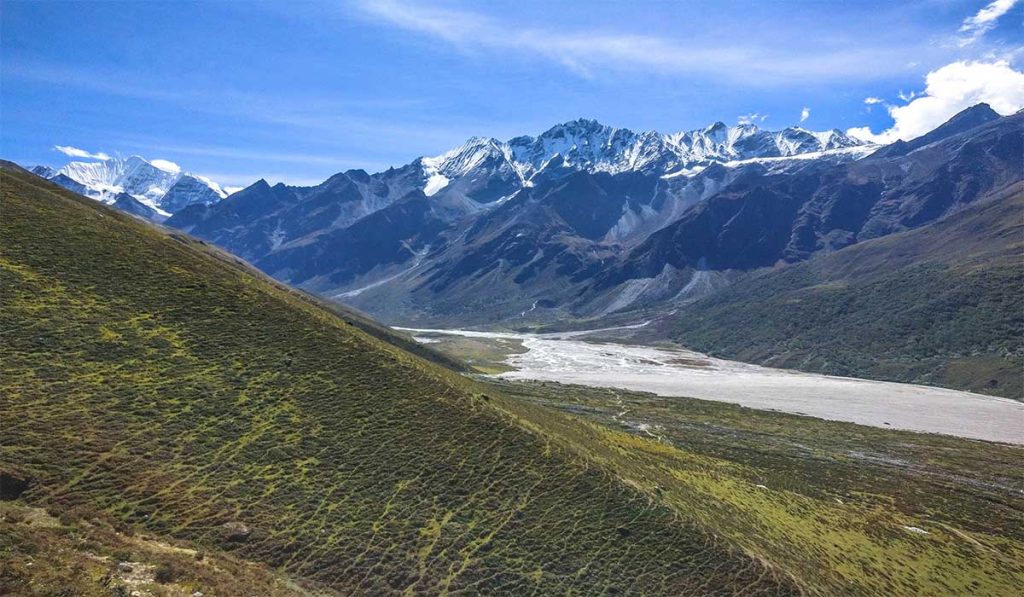
Is April a good time to trek Langtang Valley?
Yes, it is the right time for the trek as April offers clear skies, mild temperatures, minimal rainfall as well as snow-free trails.
What are the risks of trekking in April?
Risks include acute mountain sickness above 3,000 meters, sunburn due to strong UV rays, slippery descents and occasional afternoon haze. However, these risks persist throughout the year.
How should I prepare physically for the April trek?
Do cardio exercises (hiking, jogging, cycling) and leg-strength workouts (squats, stair climbing) about a month before the trek.
Are the trails safe in April?
As most snow has melted by the middle of April, it reduces slips. In addition, avalanche risks and landslides are minimal in this spring month compared to monsoon.

